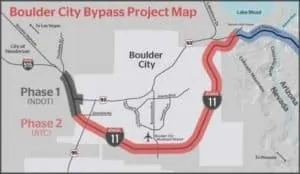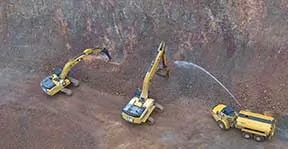

Transportation Goal
 Also known as, the Boulder City bypass, the first leg of I-11 allows approximately 34,000 vehicles a day to skip the U.S. Highway 93 route through Boulder City. Of the $318-million total project cost, $249 million in federal funding. The state of Nevada contributed $5 million to Phase 1 and the Regional Transportation Commission of Southern Nevada (RTC) supplied $63.8 million to both phases. “Construction of I-11 is critical to the continued economic vitality of Nevada,” said Gov. Brian Sandoval, who chaired the state Transportation Board. “By improving traffic flow between Las Vegas and Phoenix and providing relief to congested north-south highways like I-5 and I-15, the new I-11 will spur increased trade and commerce, advancing our economic development initiatives and ensuring we remain globally competitive.”
Also known as, the Boulder City bypass, the first leg of I-11 allows approximately 34,000 vehicles a day to skip the U.S. Highway 93 route through Boulder City. Of the $318-million total project cost, $249 million in federal funding. The state of Nevada contributed $5 million to Phase 1 and the Regional Transportation Commission of Southern Nevada (RTC) supplied $63.8 million to both phases. “Construction of I-11 is critical to the continued economic vitality of Nevada,” said Gov. Brian Sandoval, who chaired the state Transportation Board. “By improving traffic flow between Las Vegas and Phoenix and providing relief to congested north-south highways like I-5 and I-15, the new I-11 will spur increased trade and commerce, advancing our economic development initiatives and ensuring we remain globally competitive.”
The four-lane, access-controlled freeway includes 11 bridges, a scenic-view parking area overlooking Lake Mead, drainage culverts and dedicated crossings for off-road traffic and wildlife. A portion of the project skirts nearby Lake Mead with some construction through a ridge of the El Dorado Mountains.

Effective Asbestos Mitigation Plan and Environmental Protection of the Public, Plants, and Animals
After being challenged by the potentially deadly, naturally occurring asbestos found in vast areas of the Southwest, SCS Engineers monitored air levels and controlled dust on the entire site. Excavated soils remained on site. Additionally, equipment and vehicles were cleaned before leaving the project site.
Out of the more than 14,000 air samples taken in and around the project area in Phase I, none exceeded mandated levels.
The environmental plan also included protecting citizens, public areas, native plants, and desert tortoise. The project was also partially within Lake Mead National Recreation Area. Sensitive environmental areas were taken into consideration, including disturbing plants and the native desert tortoise.
To protect the desert tortoise, miles of tortoise fencing was installed, as well as culverts that provide underpasses for the endangered tortoises. The main hazardous challenge was naturally occurring asbestos (NOA) discovered in 2013, which has the potential to be disturbed during the creation of highways. SCS met the challenge of environmental monitoring and oversight of the construction activities, including the sampling of air, soil, and rocks to develop data used in calculating exposure for the workers and nearby Boulder City residents.
SCS worked closely with the RTC, Nevada Department of Transportation (NDOT), Las Vegas Paving the highway contractor, the National Park Service, and Boulder City.
Outcomes and Benefits
Opened on August 8, 2018, the first phase of Interstate 11 helped relieve congestion, improve safety, and enhance travel and commerce between Arizona and Nevada. When the second phase is finished, I-11 will connect Las Vegas and Phoenix, the only two cities in the nation with metro-area populations of more than 1 million – not linked by an interstate highway.
This contract involves the development and implementation of a Naturally Occurring Asbestos Management Plan, air and soil sampling for asbestos content, and contractor oversight. During the course of the 3-year project, SCS staff have collected over 20,000 samples to date and monitored multiple contractors performing a variety of construction tasks. SCS also provides technical oversight and management on the largest Naturally Occurring Asbestos project in the State of Nevada.